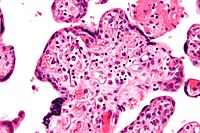
Photo from wikipedia
Microcephaly is a developmental disorder in which the head circumference, measured as an occipitofrontal, is below the third circumferential, or at least 2 standard deviations (SD), relative to age, gender,… Click to show full abstract
Microcephaly is a developmental disorder in which the head circumference, measured as an occipitofrontal, is below the third circumferential, or at least 2 standard deviations (SD), relative to age, gender, and ethnic origin. The aim of this study is to evaluate the diagnostic approach of microcephaly in childhood and to determine the prevalence of various underlying causes/diseases, and to determine a standard diagnostic approach according to disease frequency. 1474 patients who had microcephaly and from prenatal 32nd gestational week to 18 years of age was admitted to any of the outpatient clinics of Hacettepe University Hospitals between July 2012 and July 2017. The patients‘ head circumference distribution (SDS) was -2/-3 with a rate of 24.97%, the ratio of patients with -3/-4 was 30.6%, the ratio of patients with -4/-5 was 18.3% and -5/- The rate of patients with 6 was 11.87%. According to the majority of patients, 68,72% were genetic, 4,21% were related with chronic disease, 3,73% were related to metabolic disease and 3,39% were found to have a perinatal/antenatal brain injury etiology. Of the 906 patients who had records for the seizure history, 39% were diagnosed with epilepsy and 93.77% of these patients had clinical seizures and an electroencephalography-determined seizure. The rate of global growth retardation was determined as 88.6% in the patients with developmental evaluation abnormal by DENVER II developmental screening test. When DENVER II findings of the patients with growth retardation were evaluated in terms of area, it was found that 91.1% of the patients had language, 82.7% had personal and social, 89.3% had gross motor and 87.1% had thin motor field regression. The patients with WISC-R were found to have a mild intellectual disability rate of 51.1% (n = 24), a moderate mental disability rate of 44.7% (n = 21) and a severe mental deficiency rate of 4.3% (n = 2) determined. 29.72% of patients who underwent cranial MRI showed abnormal findings. Cerebral anomaly was found in 94.3% of patients with abnormal cranial MRI findings, 16.7% had brain stem dysplasia, 11.6% had cerebellar anomalies, 1.4% had pituitary gland hypoplasia and 0.2% had meningoencephalocele were detected. Therefore, microcephalic patients should be closely monitored in terms of epilepsy, mental insufficiency and global growth retardation, and counseling should be provided to their families. In addition, it was found that cranial MRI was important for the clarification of some etiologies.
Journal Title: Archives of Disease in Childhood
Year Published: 2019
Link to full text (if available)
Share on Social Media: Sign Up to like & get
recommendations!